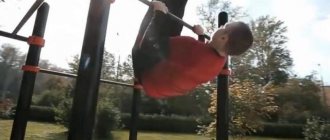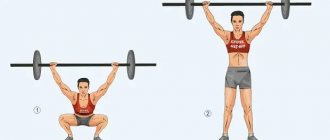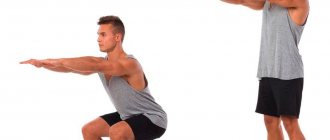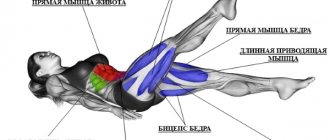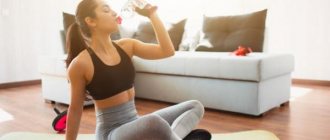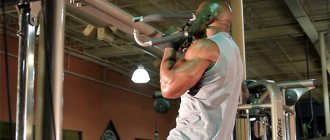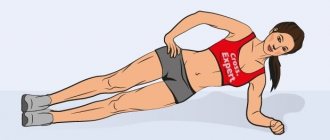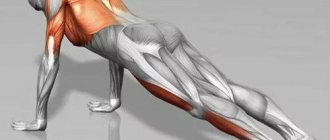The “frog” exercise came to us from yoga, where it can be found under the name “bhekasana”. In fitness and gymnastics, it is used for stretching and warming up joints and tendons.
Maria Andrianova
stretch coach and certified personal fitness trainer
This is one of the few poses that is used to achieve a cross split.
8 Stupid Myths About Stretching You Should Stop Believing
What happens if you suffer pain while stretching?
How to make a “frog” correctly?
Technique:
- get down on all fours;
- We spread our legs to the sides;
- keep your knees and hips straight;
- gently lower your forearms to the floor. At the same time, we bend our back as much as possible;
- press your feet to the floor.
You should stay in the pose for 30 seconds. Repeat 6-8 times.
It is generally accepted that the correct execution technique is when 90 degree angles are maintained everywhere. However, this is a misconception that came to us from sports.
The frog can be absolutely anything: an acute or obtuse angle between the thigh and lower leg, the pelvis parallel to the floor or not. The main thing is that it is comfortable and painless to be in this position. After all, everything is individual and largely depends on the structure of the joints.
Execution technique
The movement is technically simple if a person can, in principle, spread his legs to the sides with support on his knees to a sufficient amplitude. For those whose joints hurt already at the start, a different stretch is recommended.
For everyone else, the following algorithm is suitable:
- place your emphasis on your knees, stand on them, and spread your legs to the sides to a comfortable depth;
- shins lie on the floor, palms rest on the floor;
- take steps with your palms forward, stretch out as far as possible;
- move your knees to the sides;
- stretch your inner thighs, try not to lean forward and backward;
- after finishing the exercise, carefully transfer your body weight to your forearms, “pull” your legs to the center and stand up
Exercise frog | Cross split stretch | (FITPRO | Time to be better! Take action)
How is exercise useful?
- Speeds up metabolism.
- Improves blood circulation, which helps prevent varicose veins.
- It tones the muscles, and after performing it you feel a surge of strength.
- Allows you to load the muscles of the hips, abdomen and buttocks.
In addition to all of the above, by performing this exercise regularly, you will relieve stress from your spine, improve endurance and coordination, and your muscles will become more elastic. A sufficient amount of time and effort will even allow you to do the splits, which is often the main goal of performing this exercise.
When to start exercises for babies?
Reasonable physical activity is useful at any age, but the capabilities of a newborn are very limited, so the first sessions with a baby will be little like traditional “morning exercises”. For babies 2–3 months old, the best training is massage.
Ventilate the room and make sure nothing will distract you and your child from exercising. For children, a comfortable environment during a massage is very important, otherwise they begin to be capricious and “squeeze.” Undress the child. If the room is cool, wear light clothing that does not restrict movement. Choose a flat and hard surface to practice on, such as a table, and place a diaper or towel on top. Start your massage session by following these guidelines:
- Place the baby on his back and begin to slowly and gently stroke his body - first the head, then the arms, tummy, legs.
- Talk to your baby constantly, you can tell him a fairy tale or sing a song - he still won’t understand anything, but his mother’s voice will have a calming effect on him.
- Try turning your baby over onto his stomach and massaging his back. Some children don't like this position, so watch your baby's reaction. If your baby is unhappy, roll him back onto his back.
- You can use oil for massage, but it is not necessary. It should be edible (the chances of your baby licking his fingers are quite high), odorless and suitable for baby's skin. To make sure of this, before the first use, apply a drop of oil to your baby’s skin, rub it in and monitor the reaction for several hours. It is best to consult with a specialist and choose the right remedy together.
- Continue the massage as long as you both enjoy it.
Such exercises for a baby are excellent muscle exercises, but not only. Massage relaxes, improves sleep, promotes faster growth of the baby and, most importantly, helps to establish a close emotional connection between the child and his mother.
Are there any contraindications?
The “frog” is quite difficult, so before you start doing it, you need to warm up. In addition, people with problematic hip joints, knees and ankles should refrain from performing this exercise. Also, the “frog” will not benefit overweight people, since the load on the joints can be traumatic.
Photo: instagram.com/smstretching
Exercises against varicose veins of the legs: prevention stage
You don't have varicose veins and want to avoid developing them in the future.
Proper physical activity is a good way of prevention, so we recommend starting with daily walks: walking or cycling. Swimming is very helpful in preventing varicose veins; we just note that all of the listed types of physical activity should be present in your life regularly. Experts also recommend performing a set of exercises, mainly for the legs, which will help avoid problems with veins. Their main task is to “include” the leg muscles in the work, but not to put unnecessary stress on them.
- Sitting on a chair, stretch your legs and perform circular movements with your feet in turn (15 times with each leg).
- Sitting on a chair, place one foot on your toes and the other on your heel. Change position. Repeat 10-15 times.
- From the same starting position, place your feet on your toes, pulling your heels as high as possible. Smoothly lower your feet. 10-15 repetitions. The same exercise can be done for each leg separately.
- Standing on the floor, rise onto your toes (can be done with support) and lower onto your heels. 15 reps. The same exercise can be performed with your feet shoulder-width apart and, lowering yourself, squatting.
- Stand on the floor, feet shoulder-width apart. As you inhale, alternately rise on your toes or on your heels (the toes rise as high as possible). As you exhale, return to the starting position. 15 reps.
- The exercise is performed from a starting position standing with support on a chair. As you inhale, the leg moves smoothly to the side, and as you exhale, it lowers. 15 repetitions on each leg.
- From the starting position lying on your back, perform the bicycle or scissors exercise. This exercise can be made more difficult if you perform it from a sitting position (on the edge of a chair).
- Lying on your back, raise your legs straight up. From this position, pull your socks towards you, then return your feet to their original position. Do 10-15 times.
- Lying on your back, stretch your legs up, toes pointing to the ceiling. From this position, spread your straight legs and bring them together. 10-15 repetitions.
- Starting position - sitting on the floor with support on your hands. Legs are bent at the knees. Hold a small ball between your legs, tense your legs, then relax. 10 reps.
You can create for yourself the optimal set of these and other exercises for varicose veins on the legs. It is not necessary to do them all, but you can and should devote 10-15 minutes a day to your health. If you regularly play sports in the gym, then change strength training to water aerobics or Pilates - these are excellent types of exercise therapy for the prevention of varicose veins of the lower extremities.
Complete the complex with a contrast shower or foot bath.
Common mistakes
Maria:
It happens that the client has a physiological limitation in the mobility of the hip joint, which does not allow the leg to move further. And they offer to press the person so that he sits down completely. Naturally, there will be injury. Therefore, here are two main mistakes: the inability to listen to the body and read signals in pursuit of an enviable goal and the use of passive stretching (in other words, stretching with the help of a partner). Hence, sprains of the inner thigh and injuries to the hip joint.
Therefore, this undoubtedly useful pose should be approached with knowledge and caution.
What exercises should I do with my baby at 4–5 months?
At this age, the child learns to roll over from back to tummy and back. Usually the baby learns this simple skill on his own, but if you think he needs help, try the following exercises to train your baby’s turning over skill:
- Place the baby on his stomach. This is not the most comfortable position, and he may want to roll over after a while. Help him a little to show him how it's done.
- Place your child on his side and place his favorite toy next to him. By trying to reach it, the baby can learn to roll over onto his stomach.
- Make the exercise more difficult with a toy. Place your baby on his back and tease him a little with an interesting toy, then place it on his side. Trying to reach the toy, he will try to roll over. If the existing skills are not enough, give him a gentle push with your hand.
If you tried these exercises for the development of your baby, but did not achieve results right away, that’s okay. Your baby is not ready for rollovers yet: wait a few days and try again.
What are the benefits of stretching for the body (stretching)
Proponents of stretching (from the English stretch - pull) are convinced that it benefits the body and is important not only to surprise others. Some firmly believe that there is no benefit from stretching. But how are things really going?
The most important benefit of stretching is the noticeable improvement in flexibility. This can help you perform some strength exercises through the full range of motion, making them more effective.
Stretching has also shown itself to be a good rehabilitation practice for people, for example, suffering from neck or knee pain.
However, contrary to popular belief, stretching does not prevent the risk of injury if you do it before exercising.
In addition, studies have shown that stretching before the main workout can even reduce strength indicators.
But after the main active workout, it’s time to do a little stretching. This will help stretch and relax the muscles of the body and prevent or reduce pain after exercise.
Recommendations for performing the leg stretching complex
Follow these tips and your workouts will become even more effective:
- To get noticeable results, you need to stretch regularly. 3-4 times a week will be enough.
- It is better to do a stretching complex (suples) in the evening rather than in the morning. The muscles have warmed up and stretched during the day, so it will be easier to perform the exercises.
- You need to exercise for at least 30 minutes. We hold each position from 15 seconds to 1 minute.
- Before stretching, it is advisable to warm up the muscles: do swings, squat, otherwise you can pull the ligaments and muscles of the leg.
- Static stretching is safer than dynamic stretching, but this does not mean that you cannot help yourself by swaying. However, here you need to understand moderation: there should be no sharp jerks with a large amplitude (watch the training video).
- You should not feel much painful tension in your legs. There is no need to stretch until it hurts.
- The most important thing is to try to relax in each position. Only when you relax do the muscles begin to stretch.
If you are not a very flexible person by nature and are sure that it is too late for you to do stretching and nothing will work, this is a misconception. The older a person is, the longer it may take to see visible results, but anyone can improve their flexibility.
Frog pose in yoga
One of the healing dynamic asanas in yoga is bhekasana or frog pose. It is an excellent way to massage the abdominal cavity, develop the legs, back, knee joints, and is indicated for gout, rheumatism, and venous dilatation. However, this asana should not be performed by those who suffer from insomnia, have problems with blood pressure or have suffered spinal injuries.
The classic frog pose in yoga is performed like this:
- Lie on your stomach, put your hands behind your back, lower your face.
- As you exhale, stretch your legs, smoothly bend your knees, carefully bringing your heels towards your pelvis.
- Hold your heels with your hands, and while inhaling, slowly raise your head and body, arching your lower back and pulling your elbows and shoulders back.
- Stay in this position for 20-30 seconds, lie back, relax.
- In addition to the classic version of the asana, which is a little difficult and tough for beginners, there is an easier, simplified way of the frog pose, when only one leg is raised.
Mechanism of weight loss
The main benefit of any jumping is burning calories. How much you can burn depends on the intensity and pace of the workout, as well as on the initial weight of the student. If, for example, we take an average person with a body weight of 70 kg, then in 1 hour of exercise, depending on the exercises performed, he will lose the following amount of energy:
This calorie table clearly shows which exercises are best used in weight loss programs.
Such classes will fight in other areas:
- strengthen the heart muscle;
- actively burn and remove fat deposits;
- provide natural ventilation of the lungs;
- improve endurance;
- develop muscles;
- remove cellulite.
There is no need to consider jumping as effective primarily for losing weight in your legs. The main load, of course, falls on them, but the arms and abdominal muscles are also involved in this process. Almost all parts of the body are worked on, albeit unevenly. But in the end, you will get not only beautiful, slender legs, but also an elastic butt, a flat stomach, and no fat folds on the sides.
The first results will appear only after 2-3 weeks of intense and regular training. If you exercise for half an hour a day, you can lose 5 kilograms in a month. If you increase the load and at the same time establish proper nutrition, the weight loss will be more impressive and noticeable, then the indicators on the scales will be different - minus 7-8 kg.
BASE jumping.
This is an extremely extreme and dangerous sport in which jumps are carried out from fixed objects (buildings, bridges) using a special parachute. Please note that such exercises do not contribute to weight loss.
